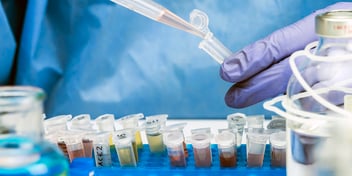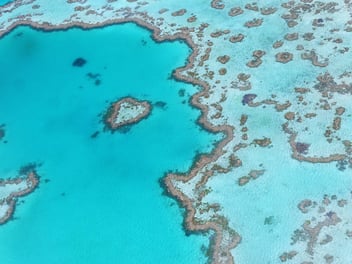Monitoring water quality from space

CSIRO’s AquaWatch Australia program is using satellite observation, data analysis and artificial intelligence to develop an advanced new system that will monitor water quality. Here’s how it’s going – according to one participating NSW water utility.
Set to discuss their experiences with the trial at Ozwater’23 in May are Andy Olrich and James Van Der Helm, from Hunter Water, whose Grahamstown Dam is one of multiple sites nationally participating in the program.
“It's just fascinating that we are utilising our national space program to help drive better ways of managing water quality through our rivers and coastal water resources,” said Olrich, Hunter Water’s Continuous Improvement and Innovation Lead.
“It's space and water science coming together for the benefit of potentially millions of people here and around the world.”
Along with sites at Lake Hume in New South Wales and Victoria, and Lake Tuggeranong in the ACT, the CSIRO hopes the work at Grahamstown will one day lead to a national integrated system that can provide holistic aquatic ecosystem information.
AquaWatch combines data from innovative ground-based monitoring equipment and satellite remote sensing, which is correlated with weekly water-quality testing undertaken by boat, to monitor the presence of cyanobacteria in drinking water sources.
“It is monitoring water quality – more specifically, it’s monitoring for the presence of algae. When conditions are favourable for algae to accumulate in the water at sufficient concentrations, the algae can release colours into the water,” said James Van Der Helm, Senior Environmental Scientist at Hunter Water.
“The pigments change the reflectance signature of the water, so the instrumentation is actually looking at that change in reflectance, which is calibrated against blue-green algae, suspended solids and coloured dissolved organic matter.
“Then, using that data and algorithms, we can monitor current algal conditions and forecast or predict the likelihood of an algal bloom occurring.”
Reducing risk
Both Van Der Helm and Olrich highlight the advantages a satellite system has for Hunter Water’s monitoring of Grahamstown Dam – in terms of the functionality of the system, water quality monitoring across the entire dam, as well as reducing the risks to the utility’s workers.
“The logistics of going out and collecting manual samples – sending people over the water, going out in boats, collecting samples, and then [again] if we need to do follow-up samples – presents some hazards and risks that we're always looking to try and reduce for our people,” said Olrich.
“We are currently monitoring from three discrete points, and that dam is 28 square kilometres in area. So for us to get more frequent and broader visualisation of what the entire dam's doing, that's really a great opportunity for us.”
Van Der Helm added that the approach could lead to manual inspections becoming much less frequent for monitoring algal risk.
“The system has potential to provide cost-effective water quality monitoring that can be deployed across the globe. After we have finished the process of local calibration and validation, then we may no longer need to rely on the regular manual aspects of water quality monitoring and sampling and analysis of water samples,” he said.
“We can utilise satellite remote sensing technology and imagery to assess water quality and the likely risk of algal blooms occurring. So it's very, very exciting from that perspective, and has immediate local relevance as well as international relevance.”
More data needed
At the current stage of the trial, the ground-based data allows the researchers to produce a baseline that they can then compare to the analysis produced from the satellite information.
“We're still in the preliminary stage – so we are still amassing the baseline data and the validation data,” Van Der Helm said.
“We're collecting water samples from the immediate vicinity of the monitoring equipment itself and then sending those to the lab for analysis.
“Then we forward that data to the CSIRO who look at the reflectance signatures in the background, then correlate the reflectance signatures they see with the raw water quality data we are providing. CSIRO applies modelling and algorithms over all the data to provide the monitoring and forecasting tool.”
By the middle of this year, he said, the program should have produced a reliable data set. Then, in September, the CSIRO and Hunter Water plan to add another testing device in the nearby Williams River, from which Hunter Water pumps the raw water that’s stored in Grahamstown Dam.
“The original plan was to have this one device in Grahamstown for 12 months and then take it over to the Williams River and then do some collection there,” Olrich said.
“They've asked us to leave this particular unit in Grahamstown Dam for the full two-year trial now and procure another one to put in the Williams. We're getting so much good [data] out of this, that we don't want to remove it from this location yet.”
After those two years are up, Hunter Water will retain the equipment and continue to access the data, which it will implement into the existing monitoring and visualisation systems used by its teams.
One important aspect of the study, Olrich said, was its timing: Hunter Water expects increased algal blooms in the future.
“With the future challenges around climate change and the predicted increased risk of algal blooms, I think it's very good timing and it's great that we're on this journey now in the water space,” he said.
“It's good that we have been early adopters of trialling this new approach and it's going to future proof a lot of things.”
Van Der Helm agreed that climate change would increase the importance of being able to access high-quality drinking water.
“We all need clean, safe drinking water and as we move toward an uncertain climate future, we need as many tools as possible to manage those resources,” he said.
Interested in hearing more about Hunter Water’s work with CSIRO on AquaWatch? Register for Ozwater’23 here.


